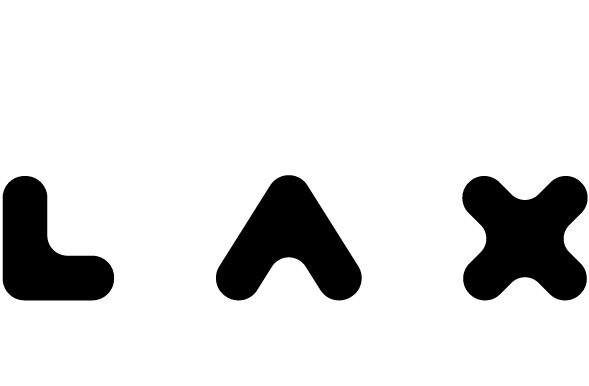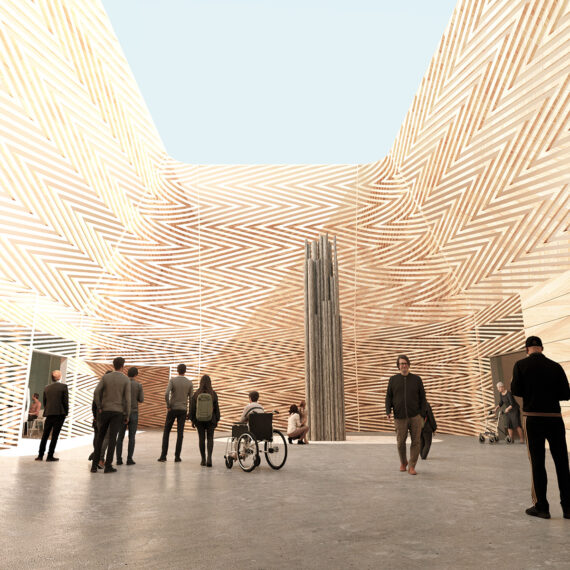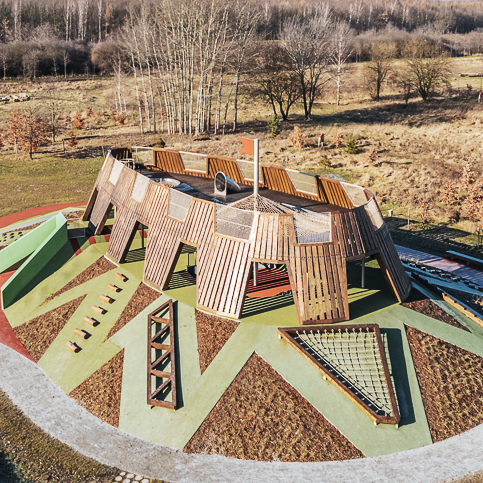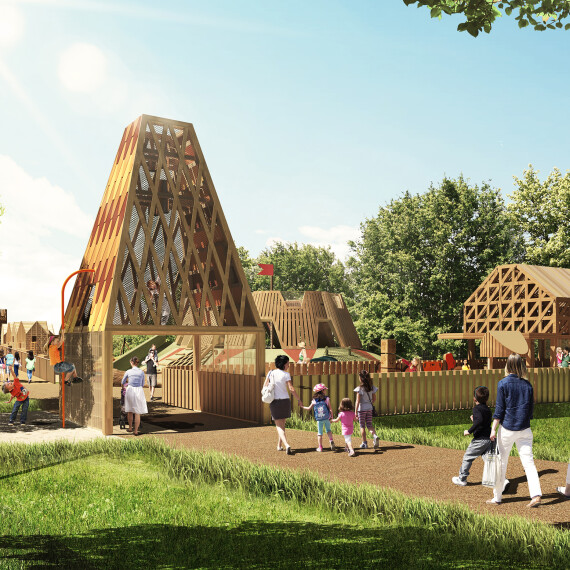AUREOLA obręcz świetlna

Form and material
The form of the Aureola refers to the morphic shapes of nature, freely entwining the green urban elements. The shape waves at different heights, allowing passers-by to sit, lean back or touch the Aureola. In addition, Aureola allows you to change the plait coverage area, once adapt to a square fragment of green, once to a rectangle. Mounting on delicate metal legs gives a sense of lightness, and thanks to their amounts ensures the stability of the furniture. Emphasizing the naturalistic nature of the element, it was decided to have a composite material based on polyester resins in a cool green color, with a high level of gloss and delicate transparency. Built in this way, the luminous rim creates a diverse spatial composition in various places, which on the one hand contrasts with the surrounding architecture and on the other hand a harmonized background for fauna and flora.
Interactivity
The idea of the Aureola as the light ring is to create an interactive element that will not only protect green areas from devastation, but will also strengthen the connection between city users and nature, showing that greenery feels and reacts as they do.
During the daytime the Aureola interact with the passerbys by making soft sounds, symbolizing the breathing of the trees. The recipients by touching Aureola create a sound spectacle.
In the evening, the Aureola lights up, showing the flowing energy of the tree. Recipients in the evening, through touch, strengthen the glow of Aureola – making the whole element come alive and pulsate.
By using sensor and actuator technologies, Aureola creates a fairytale world of flora and fauna, responding to the recipient in real time, engaging in dialogue with people and encouraging them to interaction. In technical terms, it was proposed to arrange distance sensors in the legs of the furniture responding to movement of many people; pressure sensors after the whole form react to personal, tactile interaction; indoor led lighting that varies depending on the time of day and people’s movement; and a speaker at the bottom of the form. The combination of these elements with the NUC control unit connected to the Internet will allow programming of various scenarios of interaction between the recipient, Aureola and nature.

Forma i materiał
Forma “Aureoli” odwołuje się do morficznych kształtów natury, swobodnie oplatając zielone elementy miejskie. Kształt onduluje na różnych wysokościach, pozwalając przechodniom usiąść, oprzeć się lub dotknąć “Aureolę”. Ponadto “Aureola” pozwala zmienić swój obszar zasięgu oplotu, raz przystosowując się do fragmentu zieleni w kształcie kwadratu, a raz do prostokąta. Posadowienie na delikatnych nóżkach z połyskliwego metalu daje poczucie lekkości, a zarazem dzięki ich ilości zapewnia stabilność mebla. Podkreślając naturalistyczny charakter elementu, zadecydowano o wykorzystaniu materiału kompozytowego na bazie żywic poliestrowych w kolorze chłodnej zieleni, o wysokim poziomie połysku i delikatnej przezroczystości. Zbudowana w ten sposób świecąca obręcz tworzy w różnych miejscach urozmaiconą kompozycję przestrzenną stanowiącą z jednej strony kontrast do otaczającej architektury, a z drugiej strony zharmonizowane tło dla fauny i flory.
Interaktywność
Ideą “Aureoli” obręczy świetlnej, jest stworzenie interaktywnego elementu, który nie tylko będzie chronić tereny zieleni przed dewastacją, ale pozwoli na wzmocnienie więzi między użytkownikami miasta a naturą, pokazując, że zieleń tak jak oni czuje i reaguje.
W porze dziennej “Aureola” nawiązuję interakcję z przechodniem poprzez wydawanie delikatnych dźwięków, symbolizujących oddychanie drzew. Odbiorcy poprzez dotykanie “Aureoli” nawiązują dźwiękowy spektakl.
W porze wieczornej “Aureola” rozświetla się, ukazując przepływającą energię drzewa. Odbiorcy w porze wieczornej poprzez dotyk powodują wzmocnienie świecenia “Aureoli”, sprawiając, że całość ożywa i pulsuje.
Wykorzystując do tego technologie sensorów i aktuatorów, “Aureola” tworzy bajkowy świat flory i fauny, reagując na odbiorcę w czasie rzeczywistym, prowadząc z nim dialog i zachęcając do interakcji. Pod względem technicznym, zaproponowano rozmieszczenie czujników odległości w nóżkach mebla reagujących na duży ruch osób; czujników nacisku po całości formy reagujących na personalną, dotykową interakcję; wewnętrzne oświetlenia led zmienne w zależności od pory dnia i ruchu osób; oraz głośnika w dolnej części formy. Połączenie tych elementów z jednostką sterującą NUC podłączoną do Internetu pozwoli na programowanie różnorodnych scenariuszy interakcji między odbiorcą, “Aureolą” i przyrodą.
type: architecture
status: competition
year: 2019
location: Lublin [PL]
authors: arch. Anna Grajper, arch. Sebastian Dobiesz
interns: stud. Anton Budas





